 The Failure Bow has a long and treasured history in the world of improvisational theater. Recent research demonstrates that there’s a life-changing reason why. This two-part post will show you how the technique can interrupt feelings of shame and self-defeat; deliver greater confidence, clarity, and calm—and activate waves of resilient joy. For more on changing your relationship to failure, make sure to check out the Monster Baby Podcast, especially Episode #1!
The Failure Bow has a long and treasured history in the world of improvisational theater. Recent research demonstrates that there’s a life-changing reason why. This two-part post will show you how the technique can interrupt feelings of shame and self-defeat; deliver greater confidence, clarity, and calm—and activate waves of resilient joy. For more on changing your relationship to failure, make sure to check out the Monster Baby Podcast, especially Episode #1!
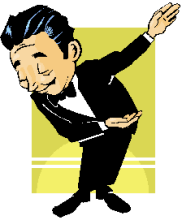 The Failure Bow (also known as the Circus Bow, Availability Bow, or Transparency Bow) represents one of the greatest resources in an improvisor’s toolkit. Putting it to use transforms the potential downer of a seeming mistake into a celebration of boldness.
The Failure Bow (also known as the Circus Bow, Availability Bow, or Transparency Bow) represents one of the greatest resources in an improvisor’s toolkit. Putting it to use transforms the potential downer of a seeming mistake into a celebration of boldness.
As far as I’ve learned, the Bow first showed up in the work of Seattle improv pioneers Edward Sampson and Matt Smith in the mid-1980’s.[1] They noticed that beginning improvisors in particular needed some way to interrupt the natural demons of self-doubt and self-judgment. Usually, we cringe when we hesitate or make mistakes, expecting punishment or pain from the outside. Or, maybe we flinch or roll our eyes hoping that if we proactively apologize for our ineptitude we can deflect critique from others. Of course, that apology only solidifies and calcifies the error, telling those around us that we’re worthy of their judgment. Sampson and Smith suggested that we instead embrace the moment by stepping proudly forward, flinging our arms in the air, and pronouncing a full-throated, goofy-smiled “I failed! Woo hoo!” The move simultaneously takes responsibility—I’m recognizing that I did, in fact, ‘mess up’—and lightens the mood, making more space for creativity. Rather than spiraling downward or inward, I choose to respond with good cheer, celebrating the boldness that led to the failure. I’m learning! I’m growing!Over time, the spirit of the gesture becomes so ingrained that the impulse to cringe almost fades away completely.
Partly, the Bow develops a skill—that of bringing attention back to the present moment—that improvisors desperately need. In the chaos of an unfolding scene on stage, there’s no time to brood over every little hiccup or misstep. If a circus clown stumbles, he won’t stop to berate or shame himself. Instead, he waves his arms triumphantly and moves with authority into a deep and magnificent bow, first in one direction, then the other. The mistake has shaken him awake. He resets his focus outward, and in so doing, gains new life. It won’t help to get locked in the past. The show must go on.
I first learned a variation, the “Ta-Da!” bow from my teacher and mentor, Patricia Ryan Madson. In her version, each player in the group practiced the technique before it was ever needed, bowing after a confident “Ta-Da!!!” and receiving raucous applause from other troupe members. Then, having developed the muscle memory as a group, we could break out the practice—and the support that went with it—whenever we needed. In her gem of a book Improv Wisdom, Madson recalls a time when she put that support to use, even when she was by herself in front of a crowd of thousands at Stanford University’s Frost Ampitheater. In 1992, she had accepted an invitation to read the words of Jane Stanford, one of the school’s founders, at the august occasion of the inauguration of new university president, Dr. Gerhard Casper. Ryan Madson continues the story:
I wore the traditional cap, gown, and academic hood under the bright California sun. The day was radiant and warm. According to the program, my reading followed a stately musical tribute to President Casper, composed for the occasion and performed by the Stanford orchestra, who were on stage behind the academic cadre. The conductor launched the stirring piece, guiding the musicians skillfully. As the music came to an end and a small silence ensued, I rose and walked to the podium, placed my book on the stand, took a full breath and declaimed: “And now, the words of Jane Stanford…” And, at that moment, the horns and violins commenced the final movement of the piece.
Wrong cue.
Oh, dear.
Understandably, Ryan Madson froze. She knew she needed to return to her seat and wait out the music and applause, but…the horror! In that moment of mortification, though, she also felt a “little tingle like angel’s wings bubbling up through my shoulders, as if I were lifting my arms in a Ta-Da Bow.” She held her head high, turned, and returned to her seat with dignity. When the music ended and the applause died down, she approached the podium again and resettled, this time beginning “And now, the words of Jane Stanford.” The audience rustled with a soft laughter, recognizing the humanness and the humor of the moment, allowing everyone—including Ryan Madson—to return to the more formal message. Even though she had only thought about the Bow, her history with it and the support she’d had from others gave her the means to stay present and turn her attention to what needed to come next. As she writes, “I did not let the miscue become the event, just one moment of it.”
In such stories, it becomes clear how the Bow shifts our reaction to failure. Even more influentially, it can also change what we define as failure in the first place. We can acknowledge the facts of a mistake—I didn’t accomplish what I intended to accomplish—while also generating an alternative interpretation of those facts, one that leads us to more productive action or more empowered choices going forward.[2] “I failed because I’m a lousy impostor” tells a radically different story than does “I goofed because I’m walking a risk-filled learning edge.” The former compounds the stumble by identifying with it; the latter incorporates it as another step on the learning path.
Seeming failures also give us the chance to weave a group’s sense of togetherness. If you help cover or transform my goof-ups with seamless good cheer and I do the same for you, we build trust for each other. We’ll want to play together again. What’s more, the audience will want to come along for the ride. We performers often strive for a show without errors, but those watching don’t. At an improv show, they want to see us stumble and then to watch us recover good-naturedly. If they want predictable perfection, they’ll take in a well-scripted play. They recognize the grace in our generosity. They see the charm of the art. They know there’s a perfection in the imperfection.
As we practice such reframes over time, mistakes morph even further. What we had once considered cringe-worthy errors soon become helpful invitations to adventure. How can we incorporate or justify the ‘mistake’? What unexpected or delightful place does it catapult us to? What’s now possible that wasn’t before? Groups who buy into this new vision of ‘failure’ create a safety net that inspires healthy risk-taking and genuine innovation. Improv troupes, corporate divisions, and classroom cohorts alike: they all reap the same benefit.
Looking to integrate the insights of positive reinforcement training so these lessons stick more quickly, I’ve been trying some new versions of the Bow in my own classes. I’m not sure I have it right yet. Drawing from Ryan Madson’s Ta-Da! version, I first had students step forward one at a time and boldly declare in full voice some mistake they’d ‘made’ (an improvised gaffe, not a real one). This morning, I opened the fridge too violently and spilled milk all over the floor! When we in the audience responded with wild applause, they would take a deep and confident bow, really soaking in the celebration. While the tweak introduced the Bow and communicated some of its qualities, I found myself wondering if we were rewarding the failure itself.
I decided to experiment further. With the next group, before taking a bow, students had to report a made-up failure and what they had learned from it. This morning, I spilled milk all over the floor and now know to be more careful! That version inched closer—reinforcing the learning rather than the mistake itself—but still felt somewhat off. With another group, I tried a third approach, asking for an unexpected benefit that emerged from the ‘failure’: After I was done cleaning the milk, I realized that the floor had needed cleaning anyway! That got at the idea of reframing the experience, but again, lacked an essential element. A fourth iteration strove to reinforce the boldness that pushes us past our limits in the first place. If we never make mistakes, we’re not learning, right?[3] This time, I had students earn their applause by improvising a three-sentence story about the risk that had led to a failure. I didn’t have much time this morning, but I wanted to get my little brother some protein. In my hurry, I spilled the milk when I opened the refrigerator door. Decent idea. Some progress. Still not satisfying.
Going forward, I see that it’s not just the learning from a mistake or the positive risk-taking that I want to reward and reinforce. Sure, it’s good to cultivate boldness in learners (and in ourselves). And yes, finding unexpected benefits after the fact trains us to see that what we originally consider an error may actually not be an error. We need not cringe if we trust that something good will come out. Added to that—and maybe more essentially—I want to acknowledge the preciousness and power of a joyful recovery. As Matt Smith affirmed in a recent conversation, “The Failure Bow isn’t designed to reward or focus on the failure. It’s designed to reward the willingness to be transparent, the capacity to remain available in the present moment, and the ability to get back on the horse without residing in shame.” It’s that awesome eagerness that leads an athlete to say “Hit me another, Coach” or a student to insist “Let me try again.” We get knocked down, but we get up again.
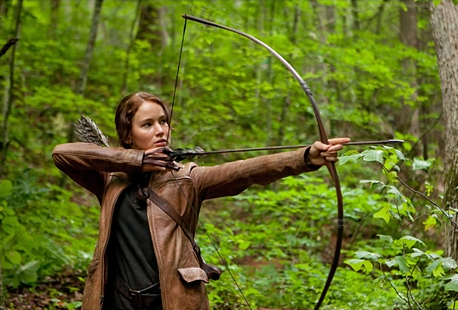
Katniss Everdeen knows how to get back up after being knocked down.
But that’s a different kind of bow altogether.
With all this consideration, I can’t wait to introduce a new choreography the next time I teach the Bow. I’ll invite my students to come up in front of the group one at a time, root themselves firmly on stage with a good, wide, athletic stance and a playful smile. Each movement from there will get its own bold assertion.
1) Extending the right arm out in a bold sweep: I took a risk!
2) Extending the left arm in similar fashion: I messed up!
3) Bringing their fingers to the chest: I’m still here!
4) Flinging both arms out and raising them triumphantly to the sky: Let’s learn!
And, of course, we’ll respond with wild applause.
[1] Many thanks to Matt for his well-honed expertise and our invigorating conversations on the subject. Thanks also to Patricia Ryan Madson, Barbara Scott, and Lisa Rowland for their thoughts as well.
[2] I once played on a volleyball team where everyone apologized after every mistake they made. When the chorus of “Sorry”s became too much, we decided to can it. Look, we know you didn’t mean it. Don’t worry about it. Let’s focus on the next play. The impulse to apologize soon turned into a humorous admission of responsibility: That shot was not what I intended. I would have liked to serve that ball over the net rather than into it. Not surprisingly, the added lightness helped us refocus on the next play.
[3] Improv luminary Keith Johnstone says that a person doing lights for an improv show should piss off his or her players on stage three times during each show. More than that and they’re being obnoxious, unhelpful, and intrusive. Fewer than that and they’re not taking enough risks. You miss the adventures and the growth if you always play it safe.
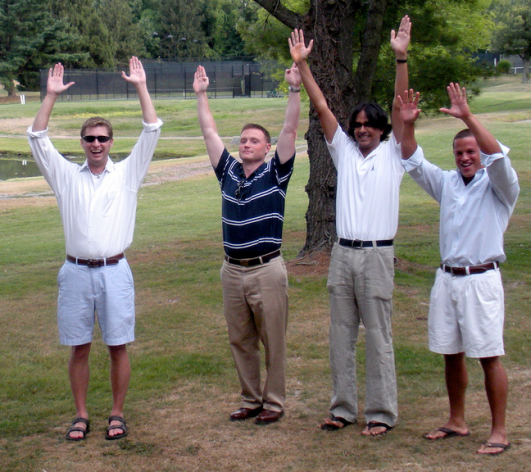
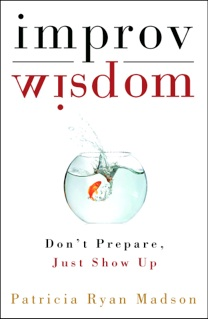
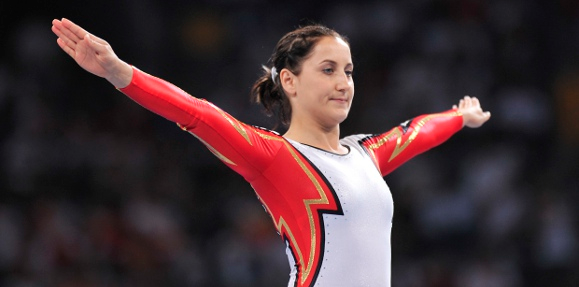
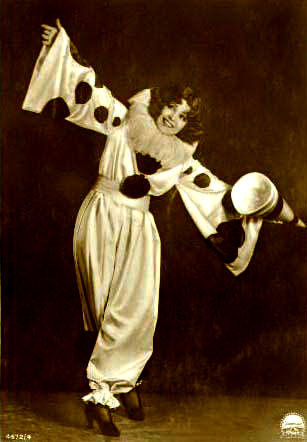
I loved this one, Ted! My own iteration is that there is no failure, only learning. I love the joyfulness of your approach.
I thought more over dinner LOL. I like that you included the *process* of your own learning. Trying things…and reporting on them.
I have a different approach to this. In the Spolin Games philosophy, success and failure are not addressed as such. The words themselves are blocks to entering into the spirit of play.
I wrote a blog about this: http://www.improv-odyssey.com/no-fail-no-fear/
Just found this. Great post (and great blog). I learned the failure Bow from Matt Smith. Wonderful teacher and improvisor. In case you haven’t sen his TedX talk/action on the topic, it is here: http://www.youtube.com/watch?v=cXuD2zHVeB0